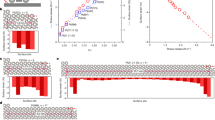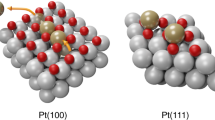Abstract
Platinum plays a central role in a variety of electrochemical devices and its practical use depends on the prevention of electrode degradation. However, understanding the underlying atomic processes under conditions of repeated oxidation and reduction inducing irreversible surface structure changes has proved challenging. Here, we examine the correlation between the evolution of the electrochemical signal of Pt(111) and its surface roughening by simultaneously performing cyclic voltammetry and in situ electrochemical scanning tunnelling microscopy (EC-STM). We identify a ‘nucleation and early growth’ regime of nanoisland formation, and a ‘late growth’ regime after island coalescence, which continues up to at least 170 cycles. The correlation analysis shows that each step site that is created in the ‘late growth’ regime contributes equally strongly to both the electrochemical and the roughness evolution. In contrast, in the ‘nucleation and early growth’ regime, created step sites contribute to the roughness, but not to the electrochemical signal.
This is a preview of subscription content, access via your institution
Access options
Access Nature and 54 other Nature Portfolio journals
Get Nature+, our best-value online-access subscription
$29.99 / 30 days
cancel any time
Subscribe to this journal
Receive 12 print issues and online access
$259.00 per year
only $21.58 per issue
Buy this article
- Purchase on Springer Link
- Instant access to full article PDF
Prices may be subject to local taxes which are calculated during checkout





Similar content being viewed by others
References
Wagner, F. T. & Ross, P. N. LEED spot profile analysis of the structure of electrochemically treated Pt(100) and Pt(111) surfaces. Surf. Sci. 160, 305–330 (1985).
Aberdam, D., Durand, R., Faure, R. & El-Omar, F. Structural changes of a Pt(lll) electrode induced by electrosorption of oxygen in acidic solutions: a coupled voltammetry, LEED and AES study. Surf. Sci. 171, 303–330 (1986).
You, H. & Nagy, Z. Oxidation–reduction-induced roughening of platinum (111) surface. Physica B 198, 187–194 (1994).
You, H., Zurawski, D. J., Nagy, Z. & Yonco, R. M. In-situ x-ray reflectivity study of incipient oxidation of Pt(111) surface in electrolyte solutions. J. Chem. Phys. 100, 4699–4702 (1994).
Nagy, Z. & You, H. Applications of surface X-ray scattering to electrochemistry problems. Electrochim. Acta 47, 3037–3055 (2002).
Sugawara, S. & Itaya, K. In situ scanning tunnelling microscopy of a platinum {111} surface in aqueous sulphuric acid solution. J. Chem. Soc., Faraday Trans. 1 85, 1351–1356 (1989).
Itaya, K. In situ scanning tunneling microscopy of platinum (111) surface with the observation of monatomic steps. J. Vac. Sci. Technol. A 8, 515–519 (1990).
Sashikata, K., Furuya, N. & Itaya, K. In situ electrochemical scanning tunneling microscopy of single-crystal surfaces of Pt(111), Rh(111), and Pd(111) in aqueous sulfuric acid solution. J. Vac. Sci. Technol. B 9, 457–564 (1991).
Breuer, N., Funtikov, A., Stimming, U. & Vogel, R. In situ electrochemical STM imaging of roughened gold and platinum electrode surfaces. Surf. Sci. 335, 145–154 (1995).
Furuya, N. & Shibata, M. Structural changes at various Pt single crystal surfaces with potential cycles in acidic and alkaline solutions. J. Electroanal. Chem. 467, 85–91 (1999).
Björling, A., Ahlberg, E. & Feliu, J. M. Kinetics of surface modification induced by submonolayer electrochemical oxygen adsorption on Pt(1 1 1). Electrochem. Commun. 12, 359–361 (2010).
Björling, A. & Feliu, J. M. Electrochemical surface reordering of Pt(111): A quantification of the place-exchange process. J. Electroanal. Chem. 662, 17–24 (2011).
Björling, A., Herrero, E. & Feliu, J. M. Electrochemical oxidation of Pt (1 1 1) vicinal surfaces: effects of surface structure and specific anion adsorption. J. Phys. Chem. C 115, 15509–15515 (2011).
Gómez-Marín, A. M. & Feliu, J. M. Pt(111) surface disorder kinetics in perchloric acid solutions and the influence of specific anion adsorption. Electrochim. Acta 82, 558–569 (2012).
Gómez-Marín, A. M. & Feliu, J. M. Oxide growth dynamics at Pt(111) in absence of specific adsorption: A mechanistic study. Electrochim. Acta 104, 367–377 (2013).
Löffler, T., Bussar, R., Xiao, X., Ernst, S. & Baltruschat, H. The adsorption of ethene on vicinally stepped electrode surfaces and the effect of temperature. J. Electroanal. Chem. 629, 1–14 (2009).
Wakisaka, M., Asizawa, S., Uchida, H. & Watanabe, M. In situ STM observation of morphological changes of the Pt(111) electrode surface during potential cycling in 10 mM HF solution. Phys. Chem. Chem. Phys. 12, 4184–4190 (2010).
Liu, Y., Barbour, A., Komanicky, V. & You, H. X-ray crystal truncation rod studies of surface oxidation and reduction on Pt(111). J. Phys. Chem. C. 120, 16174–16178 (2016).
Goryachev, A. et al. Synchrotron based operando surface X-ray scattering study towards structure-activity relationships of model electrocatalysts. ChemistrySelect 1, 1104–1108 (2016).
Drnec, J. et al. Initial stages of Pt(111) electrooxidation: dynamic and structural studies by surface X-ray diffraction. Electrochim. Acta 224, 220–227 (2017).
Ruge, M. et al. Structural reorganisation of Pt(111) electrodes by electrochemical oxidation and reduction. J. Am. Chem. Soc. 139, 4532–4539 (2017).
Ruge, M. et al. Electrochemical oxidation of smooth and nanoscale rough Pt(111): An in situ surface X-ray scattering study. J. Electrochem. Soc. 164, H608–H614 (2017).
Clavilier, J., El Achi, K. & Rodes, A. In situ characterization of the Pt(S)-[n(111) × (111)] electrode surfaces using electrosorbed hydrogen for probing terrace an step sites. J. Electroanal. Chem. 272, 253–261 (1989).
Rodes, A., El Achi, K., Zamakhchari, M. A. & Clavilier, J. Hydrogen probing of step and terrace sites on Pt(S)-[n(111) × (100)] electrodes. J. Electroanal. Chem. 284, 245–253 (1990).
Rodes, A. & Clavilier, J. Electrochemical study of step reconstruction on platinum surfaces belonging to the [011] zone between Pt(311) and Pt(111). J. Electroanal. Chem. 344, 269–288 (1993).
Clavilier, J. & Rodes, A. Electrochemical detection and characterization at Pt(N,N,N-2) oriented electrodes of multiatomic step formation induced by quenching at high-temperatures. J. Electroanal. Chem. 348, 247–264 (1993).
Solla-Gullón, J., Rodríguez, P., Herrero, E., Aldaz, A. & Feliu, J. M. Surface characterization of platinum electrodes. Phys. Chem. Chem. Phys. 10, 1359–1373 (2008).
Vidal-Iglesias, F. J., Arán-Ais, R. M., Solla-Gullón, J., Herrero, E. & Feliu, J. M. Electrochemical characterization of shape-controlled Pt nanoparticles in different supporting electrolytes. ACS Catal. 2, 901–910 (2012).
Van Der Niet, M. J. T. C., Garcia-Araez, N., Hernández, J., Feliu, J. M. & Koper, M. T. M. Water dissociation on well-defined platinum surfaces: The electrochemical perspective. Catal. Today 202, 105–113 (2013).
Huang, Y.-F., Kooyman, P. J. & Koper, M. T. M. Intermediate stages of electrochemical oxidation of single-crystalline platinum revealed by in situ Raman spectroscopy. Nat. Commun. 7, 12440 (2016).
Topalov, A. A. et al. Dissolution of platinum: Limits for the deployment of electrochemical energy conversion? Angew. Chem. Int. Ed. 51, 12613–12615 (2012).
Lopes, P. P. et al. Relationships between atomic level surface structure and stability/activity of platinum surface atoms in aqueous environments. ACS Catal. 6, 2536–2544 (2016).
Gomez, R., Orts, J. M., Alvarez-Ruiz, B. & Feliu, J. M. Effect of temperature on hydrogen adsorption on Pt(111), Pt(110), and Pt(100) electrodes in 0.1 M HClO4. J. Phys. Chem. B 108, 228–238 (2004).
Furuya, N. & Koide, S. Hydrogen adsorption on platinum single-crystal surfaces. Surf. Sci. 220, 18–28 (1989).
Domke, K., Herrero, E., Rodes, A. & Feliu, J. M. Determination of the potentials of zero total charge of Pt(100) stepped surfaces in the [011] zone. Effect of the step density and anion adsorption. J. Electroanal. Chem. 552, 115–128 (2003).
Giesen, M. & Schulze Icking-Konert, G. & Ibach, H. Interlayer mass transport and quantum confinement of electronic states. Phys. Rev. Lett. 82, 3101–3104 (1999).
Lee, J., Lee, J., Tanaka, T. & Mori, H. In situ atomic-scale observation of melting point suppression in nanometer-sized gold particles. Nanotechnology 20, 475706 (2009).
Michely, T. & Krug, J. Islands, Mounds and Atoms (Springer, Berlin, Heidelberg, 2004).
Ibach, H. Physics of Surfaces and Interfaces (Springer, Berlin, Heidelberg, 2006).
Ehrlich, G. & Hudda, F. G. Atomic view of surface self-diffusion: tungsten on tungsten. J. Chem. Phys. 44, 1039–1049 (1966).
Schwoebel, R. L. & Shipsey, E. J. Step motion on crystal surfaces. J. Appl. Phys. 37, 3682–3686 (1966).
Sekerka, R. F. in Crystal Growth – From Fundamentals to Technology 1st edn (eds Georg Müller, J.-J. M. & Rudolph, P.) 55–93 (Elsevier, Amsterdam, 2004).
Sekerka, R. F. Equilibrium and growth shapes of crystals: How do they differ and why should we care? Cryst. Res. Technol. 40, 291–306 (2005).
Meakin, P. Fractals, Scaling and Growth Far from Equilibrium 119–159 (Cambridge Univ. Press, Cambridge, 1998).
Giesen, M. & Ibach, H. On the mechanism of rapid mound decay. Surf. Sci. 464, L697–L702 (2000).
Tong, W. M. & Williams, R. S. Kinetics of surface growth: Phenomenology, scaling, and mechanisms of smoothening and roughening. Annu. Rev. Phys. Chem. 45, 401–438 (1994).
Sugawara, Y., Sasaki, M., Muto, I. & Hara, N. Dissolution of platinum single crystal surfaces under potential cycling in sulfuric acid solution. ECS Trans. 64, 81–87 (2014).
Eells, W. C. Formulas for probable errors of coefficients of correlation. J. Am. Stat. Assoc. 24, 170–173 (1929).
Yanson, Y. I. & Rost, M. J. Structural accelerating effect of chloride on copper electrodeposition. Angew. Chem. Int. Ed. 52, 2454–2458 (2013).
Yanson, Y. I., Schenkel, F. & Rost, M. J. Design of a high-speed electrochemical scanning tunneling microscope. Rev. Sci. Instrum. 84, 023702 (2013).
Güell, A. G., Díez-Pérez, I., Gorostiza, P. & Sanz, F. Preparation of reliable probes for electrochemical tunneling spectroscopy. Anal. Chem. 76, 5218–5222 (2004).
Acknowledgements
The authors acknowledge LVH Coatings for supplying their Clearclad electrophoretic paint. This work is financially supported by the European Commission Horizon 2020 - Research and Innovation Framework Programme (Marie Skłodowska-Curie Actions Individual Fellowship awarded to Y.-F.H., No. 661145, DYNECAT).
Author information
Authors and Affiliations
Contributions
All authors contributed to the design of the experiment and the interpretation of the data. L.J., Y.-F.H. and M.J.R. performed the experimental work. L.J. performed the data analysis and manuscript preparation with the input of M.J.R. and M.T.M.K.
Corresponding authors
Ethics declarations
Competing interests
The authors declare no competing financial interests.
Additional information
Publisher’s note: Springer Nature remains neutral with regard to jurisdictional claims in published maps and institutional affiliations.
Supplementary information
Supplementary Information
Supplementary Figures 1–6, Supplementary References 1–3
Rights and permissions
About this article
Cite this article
Jacobse, L., Huang, YF., Koper, M.T.M. et al. Correlation of surface site formation to nanoisland growth in the electrochemical roughening of Pt(111). Nature Mater 17, 277–282 (2018). https://doi.org/10.1038/s41563-017-0015-z
Received:
Accepted:
Published:
Issue Date:
DOI: https://doi.org/10.1038/s41563-017-0015-z
This article is cited by
-
In situ/operando characterization techniques for electrochemical CO2 reduction
Science China Chemistry (2023)
-
Electrochemical scanning probe microscopies for artificial photosynthesis
Nano Research (2023)
-
Tailoring the active site for the oxygen evolution reaction on a Pt electrode
Communications Chemistry (2022)
-
Investigating the presence of adsorbed species on Pt steps at low potentials
Nature Communications (2022)
-
Electrooxidation of Acetaldehyde on Pt(111) Surface Modified by Random Defects and Tin Decoration
Electrocatalysis (2021)



